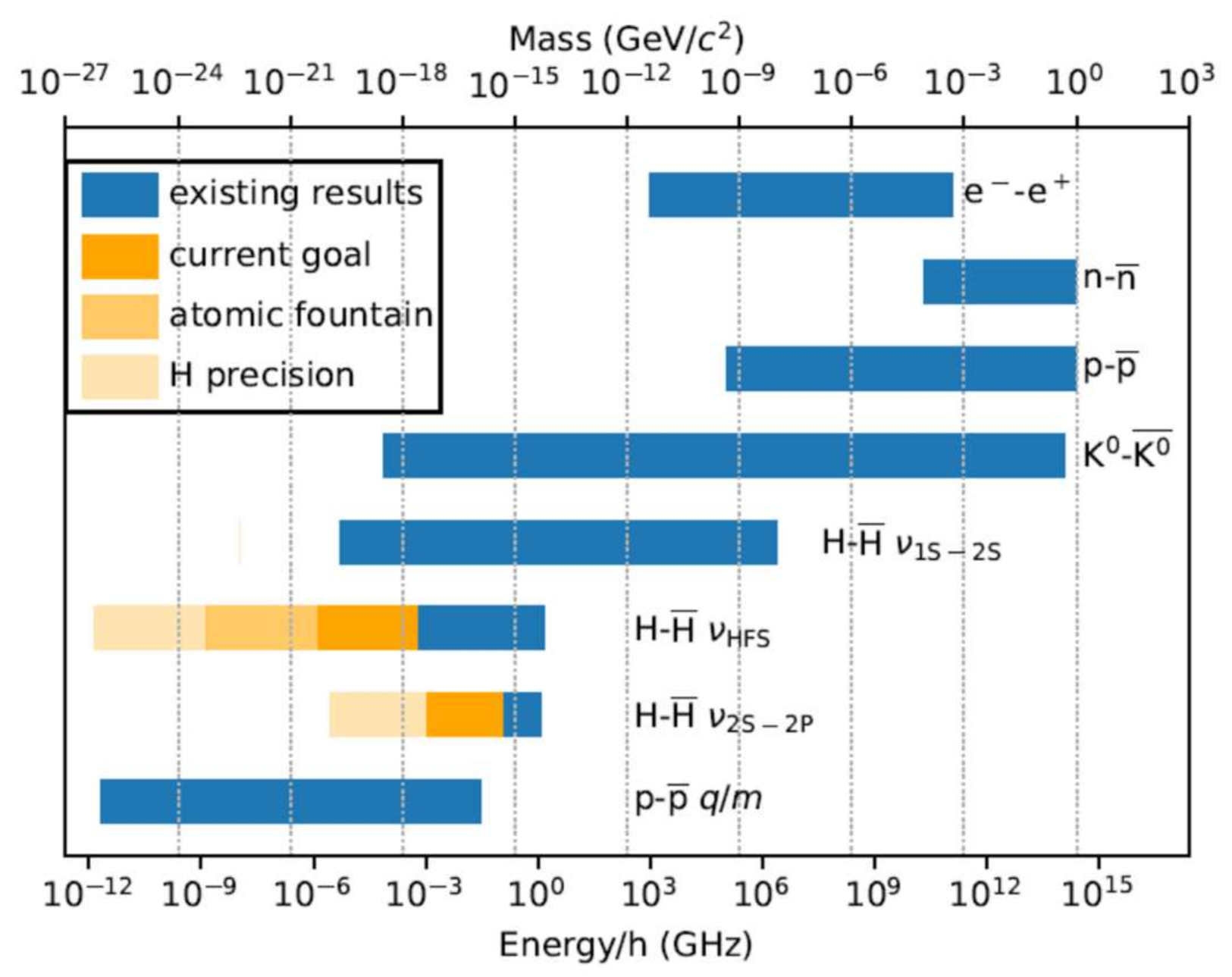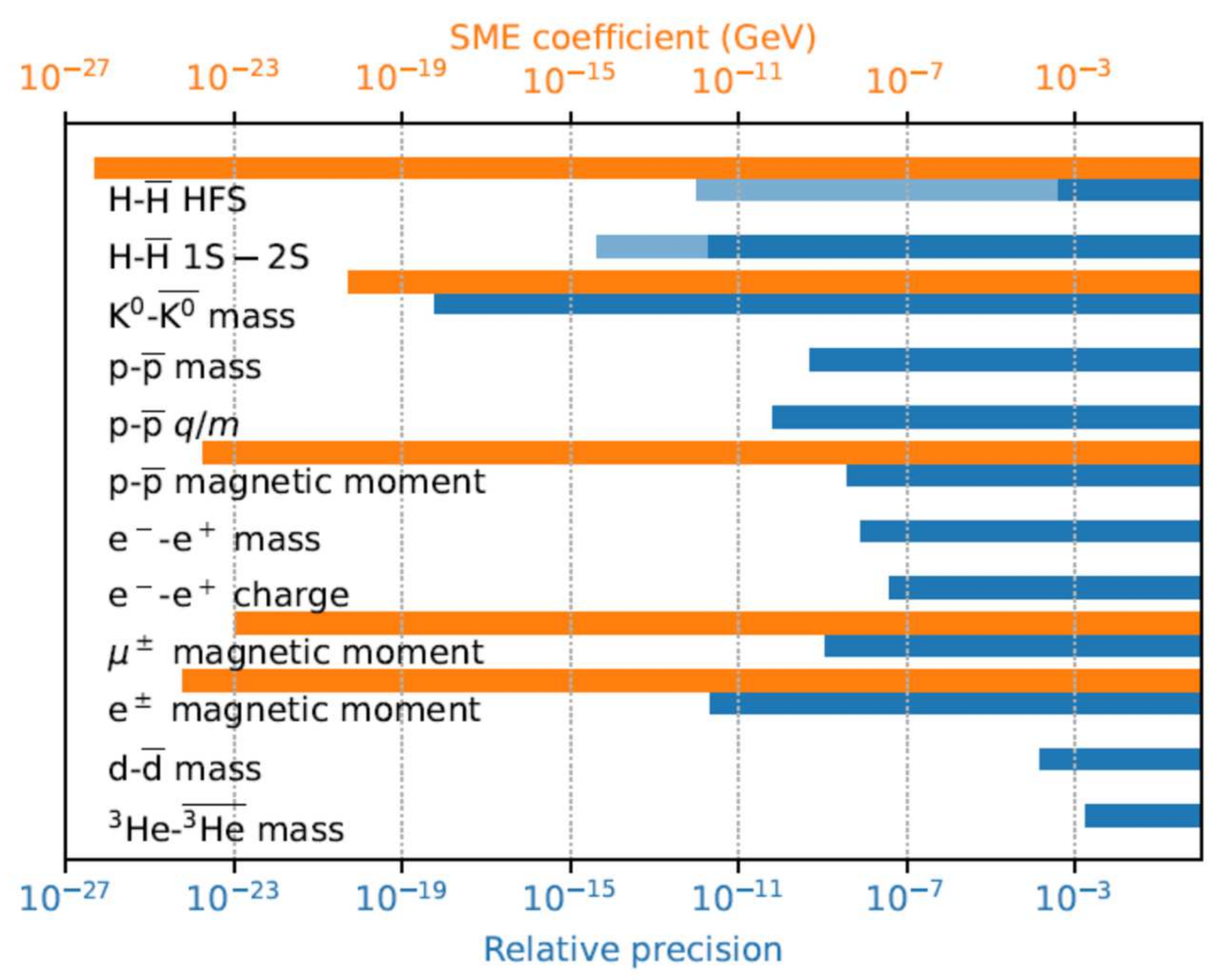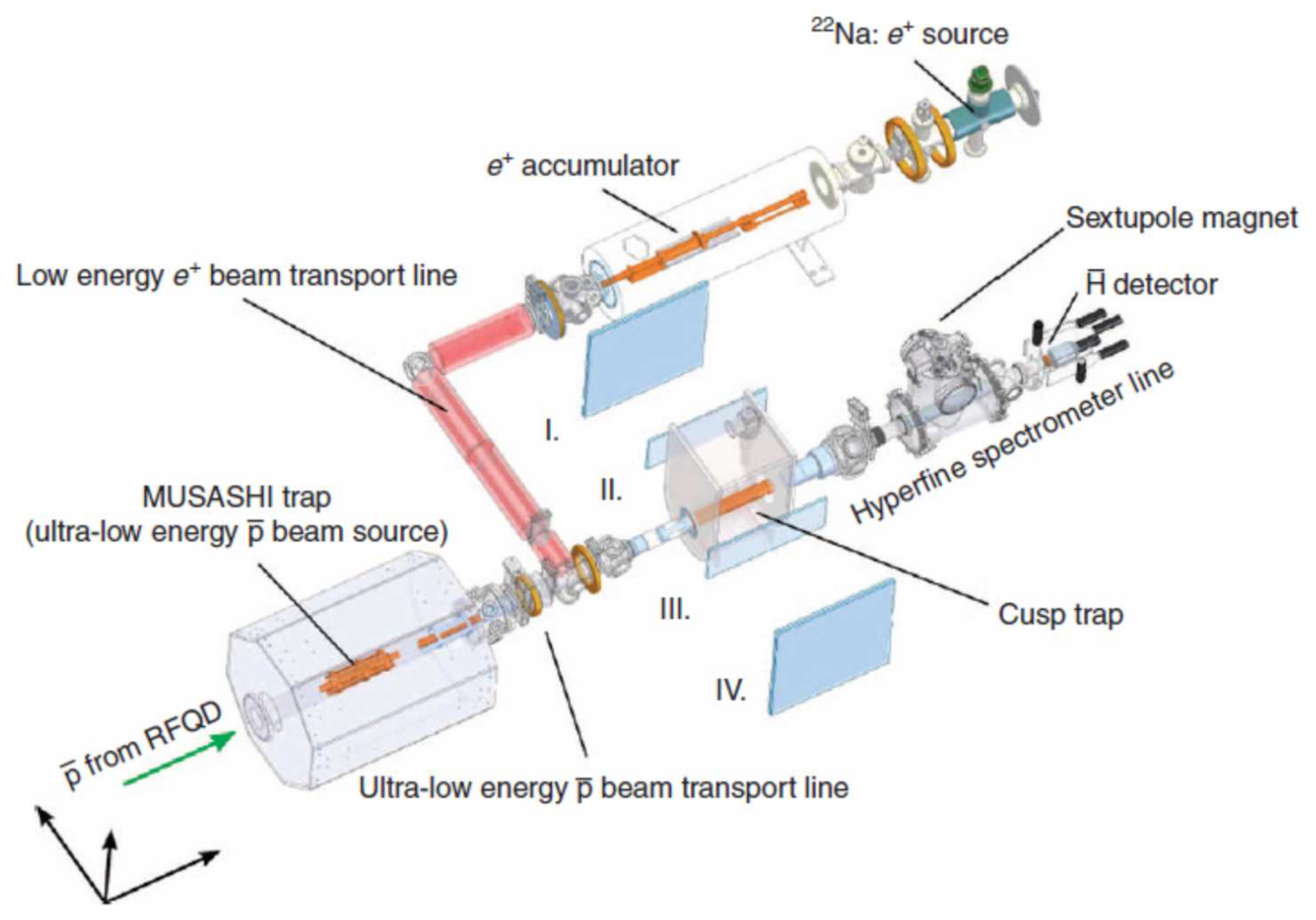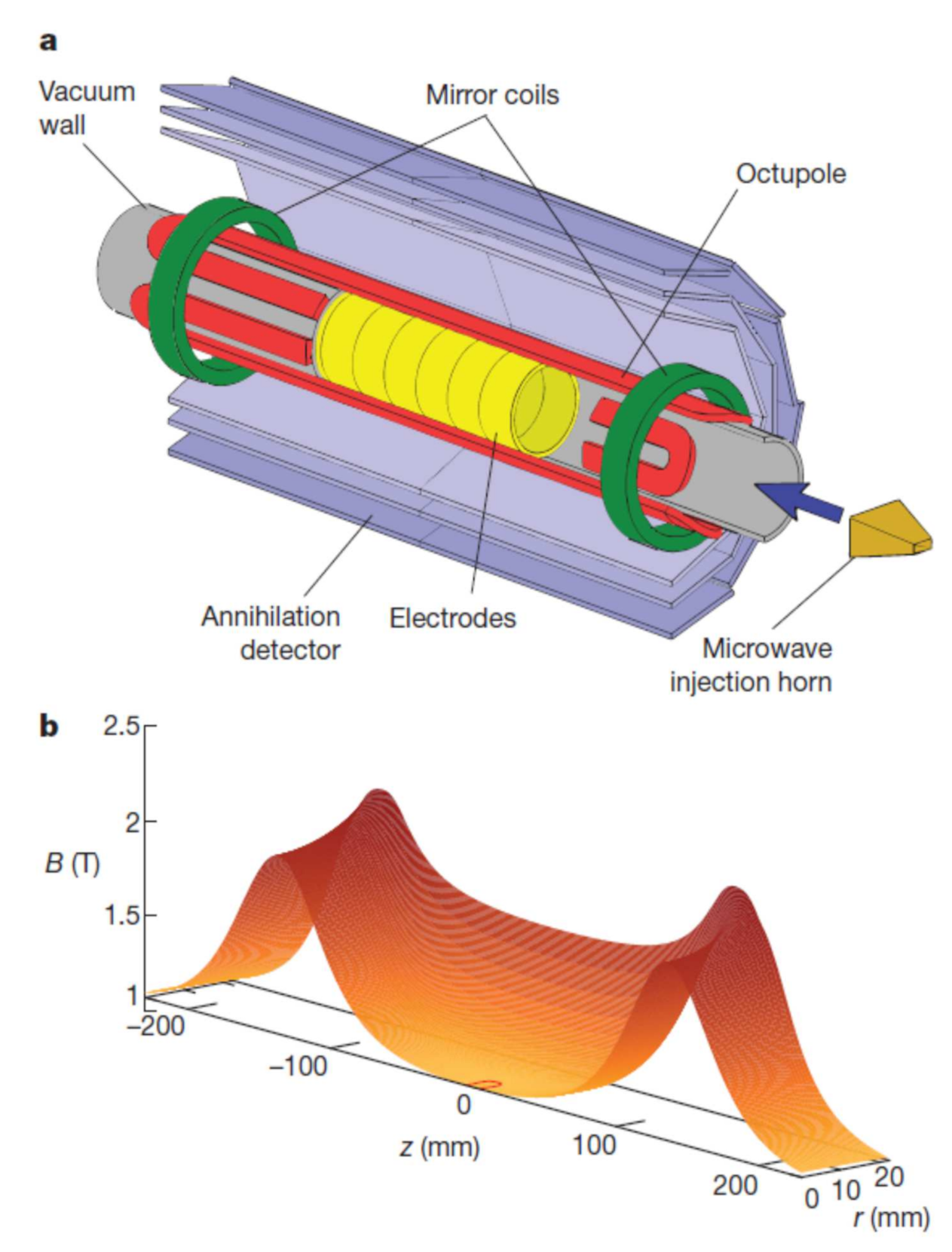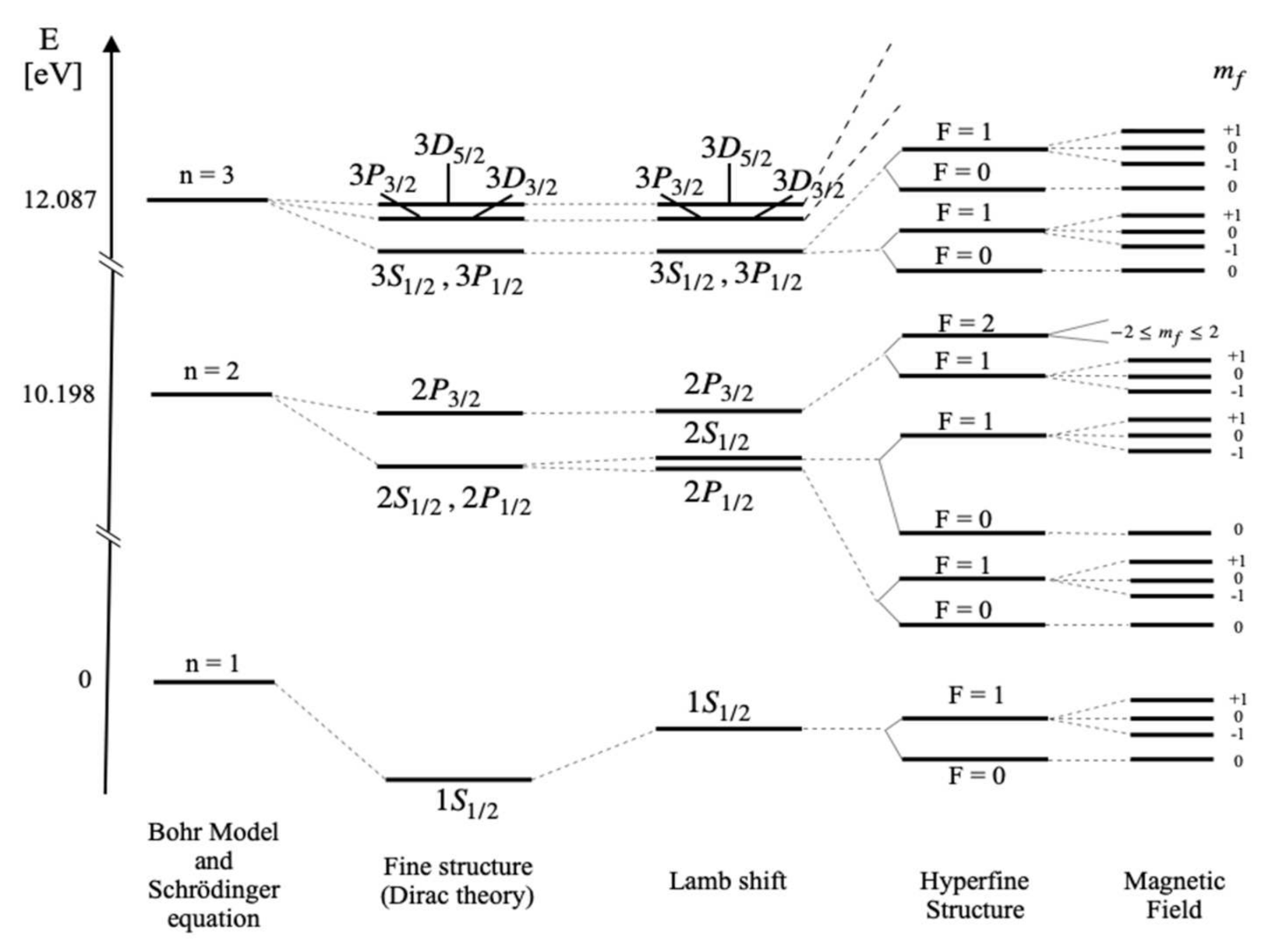1. Introduction
Antimatter entered the scene of Modern Physics with the Dirac equation [
1] and the discovery of the positron in 1932 [
2], offering a new view of particles (and the Universe) as well as an interesting ground to test physical laws at a fundamental level. Meanwhile, other antiparticles were being discovered (like the antiproton in 1955 [
3]), and the question naturally arose as to whether particles and antiparticles behaved in identical ways with respect to the laws of Physics.
The theoretical basis for testing particle-antiparticle asymmetries was set by the CPT theorem, devised in 1955 in the frame of Lagrangian quantum field theory in a flat spacetime [
4]. The theorem relates (at the quantum level) to the properties of particle and antiparticles, by explicitly constructing (for spin-0, ½ and 1 fields) the relevant CPT operators in the Lagrangian formalism. Based on the general assumptions of Lorentz invariance, locality and the hermiticity of the Hamiltonian, it implies that a particle and its antiparticle must have the same mass and lifetime and opposite electric charge and magnetic moment. After this Lagrangian-based demonstration, the theorem was also proven in the frame of axiomatic quantum field theory [
5].
In addition to the CPT theorem, the properties of a particle and its antiparticle can be related by the Weak Equivalence Principle (WEP) of General Relativity. This principle holds, in fact, for all forms of matter (energy), stating the equality of the gravitational mass of particles and antiparticles at the classical (non-quantum) level. The WEP, therefore, predicts identical behavior for particles and antiparticles in gravitational fields.
It is because of these reasons that studying the properties of antimatter might give insight into the fundamental properties of modern physical theories and their range of applicability—classical or quantum. In addition, the symmetry between matter and antimatter has very likely played a decisive role during the evolution of the Universe from its very first phase to later times, and perhaps even today, as we will discuss in the following. In this work, we will mostly focus on studying the properties of antimatter particles, keeping in mind the test of fundamental physical laws.
From the observational viewpoint, it is important to note that the effect of a CPT violation and a violation of the WEP can concur in producing experimental evidence of different behaviors of a particle and its antiparticle. Let us show this with an elementary example, assuming (somewhat arbitrarily) that CPT could be applied to the macroscopic level and using Newton’s second law. In this case, CPT invariance would lead to the equality of inertial masses of a particle and its antiparticle. Using an obvious notation:
Implying that the two species experience the same dynamical force. On the other hand, the separate validity of the WEP for the two cases of particle and antiparticle would imply that:
Supposing then, that a particle/antiparticle different behavior is observed in the Earth’s gravitational field, this could mean either a breakdown of CPT invariance through the chain:
Or, as an alternative, some level of violation of the WEP in the (much less explored) antimatter sector:
Studying antimatter transformation properties, and particularly the CPT symmetry, necessarily relates to the concept of Lorentz invariance. In fact, from the theoretical viewpoint, any level of CPT violation would necessarily imply the violation of Lorentz invariance [
6] and, therefore, signal new unconventional Physics.
Experimentally, investigations about Lorentz and CPT violation are often conducted in very different energy regimes: while Lorentz invariance is mostly studied in very high energy phenomena (e.g., in Cosmic Rays at the 10
19 eV scale [
7]), the study of CPT violation takes its preferred stage at low energies, in the form of measurements of rest masses and in the study of bound systems such as anti-Hydrogen.
Moreover, while in principle, CPT can also be studied at high energies and the relationship between variables in the reference frame of the particle and variables at rest in the laboratory is mediated by the Lorentz transformations. Therefore, an experimental CPT measurement at high energy almost always relies on Lorentz-invariance.
For this reason, since we are interested in low energies (T < MeV), in this paper, we will only focus on CPT and WEP measurements through the behavior of low energy antimatter. As already indicated, this opens the possibility of also considering antimatter bound states, such as anti-Hydrogen or Positronium. Their Atomic Physics can, therefore, be studied in detail, also considering internal transition between substates. In fact, even lower energies can be reached (T << keV) so that translational velocities are small enough to allow for the possibility of gravitational effects to be detected.
Traditionally matter-antimatter tests have been made on stable charged particles like the positron (comparing it to the electron) and the antiproton (compared with the proton). However, the importance of neutral systems containing antimatter can hardly be overestimated. First of all, the K0 system offers an important window of sensitivity through the properties of its particle-antiparticle oscillation. Secondly, only neutral systems seem to open a viable experimental path to the measurement of antimatter gravitational properties because of the effect of stray electromagnetic fields on any charged particle. Finally, systems like anti-Hydrogen offer the possibility of studying their internal transitions as sensitive CPT tests.
2. Cosmological and Theoretical Considerations
Among the most important reasons to study antimatter, its theoretical and cosmological implications stand out as a decisive topic to be addressed by modern research. These two subjects are, of course, interconnected—at least by the physics of the very first second of our Universe.
According to the most widely accepted version of the Big Bang Model [
8], all the elementary components (particles, antiparticles and radiation, etc.) were in thermal equilibrium between approximately 10
−35 and 10
−6 s of cosmic time. Quarks and gluons were just beginning to form particles, such as neutrons and protons, to fuel the subsequent stage of primordial nucleosynthesis. It was sometime during the first part of this era (i.e., the so-called Electroweak era, between 10
−35 and 10
−12 s) that an imbalance between particles and antiparticles emerged. This imbalance, at the level of one part in 10
10, was probably generated by means of the Sakharov conditions [
9], necessary for its development in the early Universe as:
- (1)
CP violations;
- (2)
Baryon number violations;
- (3)
Deviations from the thermal equilibrium.
It is generally accepted that the unbalance was present around an equilibrium energy of 1016 K in this era, which at the time of actual baryon formation (1013 K or 10−6 s), generated a Universe filled with protons and neutrons, and no antibaryons, and then matter (and not antimatter). Studying antimatter properties can therefore provide an important window to understand the origin of this cosmic asymmetry.
The most widely accepted view of the Universe and its composition features the abovementioned suppression of antimatter and also allows for the presence of dominant Dark Matter and Dark Energy components to produce an overall flat spacetime on large scales (the so-called Concordance Model, see for instance [
10]). The bold alternative possibility has been presented of a Universe with much less “Dark” components and with a repulsive large-scale force provided by antigravitation between matter and antimatter [
11,
12]—according to this scenario, the overall expansion of the Universe could be driven by repulsion between matter and large antimatter patches. While these models are considered rather speculative, they offer the advantage of not introducing unobserved (dominant) components of the Universe energy budget. In addition, they have gained more interest after a recent analysis showing that the rotational curve of stars in our own Galaxy can be explained by General Relativity corrections without recurring to Dark Matter [
13].
At the theoretical level, the motivation for studying antimatter stems from the possible CPT (and Lorentz) invariance violation in String and Quantum Gravity models [
14,
15]. These models try to address Physics at the Planck scale, where the interplay between quantum and gravitational effects might lead to the breakdown of flat-spacetime symmetries, such as the CPT invariance. In a vast class of these models [
16,
17], CPT violations can be described by means of a more general gravitational structure with respect to the usual gravi-tensor field. In the non-quantum static limit, this can be described by a gravitational potential of the form [
18]:
where
a and
b are constant coefficients, while
v and
s represent the ranges of the gravi-vector and gravi-scalar, respectively, with a CPT violation term arising spontaneously because of the different sign in front of the vector coefficient.
The most general theoretical framework to accommodate a comparison between experimental data and theory is the Standard Model Extension (SME) [
19,
20]. The SME is an effective field theory incorporating the Standard Model and General Relativity as well as all symmetry-breaking spacetime operators. It, therefore, constitutes the most general theoretical framework that is compatible with known fundamental physics (including gauge invariance, renormalizability and microscopic causality) while allowing for all possible CPT (and Lorentz-invariance) and WEP violations.
According to the SME, CPT-violating extra terms could, for instance, modify the Dirac equation for a fundamental fermion to:
Where , as usual. The additional terms aμ and bμ both violate CPT and Lorentz invariance, while the other terms only violate Lorentz symmetry. The symmetry-violating coefficients have the dimension of mass/energy, which implies that the sensitivity of a CPT-violating test should be assessed on an absolute (rather than relative) energy scale. These coefficients give the magnitude of the CPT-violating extra terms.
In order to study both the CPT invariance and the WEP at low energies, several neutral systems are produced and/or synthetized in high sensitivity experiments. The physical systems under consideration are:
Anti-Hydrogen, the bound state of an antiproton and a positron.
Positronium, the (unstable) bound state of electron and positron.
Mu-atom, the (unstable) bound state of a muon and an electron.
The most recent experimental advances leading to studies of CPT and WEP invariance with these systems are now being considered.
3. Tests of the CPT Symmetry
Tests of CPT can be done in several ways: as we already mentioned, they are generally based on the fact that the Standard Model satisfies CPT symmetry and contains the C operator relating a particle to its own antiparticle. Therefore, in any quantum relativistic system, some properties of an antiparticle can be deduced by the ones of the particle by means of this symmetry [
14]. For these reasons, CPT symmetry can be tested by studying the equality of charges, masses and lifetimes of a particle and its antiparticle. Moreover, in any bound system (like anti-Hydrogen), the internal transition frequencies should be the same as for the matter system, the Hydrogen atom.
Tests of CPT at low energies have been made in various configurations, and a summary of the current limits is presented in
Figure 1 on an absolute energy scale. In the figure, for any measurements, the length of the bar gives the relative precision of the measurement (limit on the deviation divided by the matter value of the quantity), while the sensitivity on an absolute energy scale is the location of the left border of the bar [
21].
Several of those measurements refer to the charge and mass of the particle and the antiparticle as measured in Penning trap systems: this is, in fact, the case of the electron [
22,
23], the proton [
24] and the antiproton [
25]. In addition, the magnetic moment of the antiproton has been measured at the ppm level by the CERN BASE collaboration [
26].
For what concerns the electron-positron mass difference, the most stringent limit comes from cosmology and makes use of the null mass of the photon [
27,
28], while in laboratory, the measured relative limit is at the 10
−9 level [
29], obtained by making use of the Positronium state. For what concerns the antiproton, in this case, charge-to-mass ratio studies in trap systems play an important role [
30,
31]. On the other hand, the most stringent limit on the antiproton/proton mass ratio comes from the study of antiprotonic helium [
32], a system produced when, in a He atom, an orbital electron is substituted with an antiproton.
Figure 1 also features many limits obtained by studying the anti-Hydrogen atom. The three basic quantities to be studied are the 1S-2S transition frequency, the Lamb shift and the Ground State Hyperfine Splitting (HFS). As mentioned before, they are reported on an absolute energy scale, and for some of them, a prediction is made about the sensitivity that will be reached with the predicted improvements (orange colors). The relation between the relative precision of a measurement and the relevant SME-violating parameter can be assessed by examining
Figure 2, both in terms of the relative precision (x-axis, on the bottom) and in terms of the value of the relative SME coefficient (shown on top).
4. Tests of the Weak Equivalence Principle
The weak equivalence principle is a cornerstone of General Relativity [
33] and has been tested for matter in a variety of configurations, starting from the historical Eőtvős and continuing with the most recent approaches like torsion balance experiments, free fall experiments and the measurement of the motion of celestial bodies, like in lunar laser ranging. The most sensitive recent measurements have been made in space by the MICROSCOPE satellite, reaching a level of approximately one part in 10
15 [
34]. However, all of these measurements refer to matter systems, which is in striking contrast with the paucity of information we have in the case of antimatter.
The only measurement with antimatter has been made by the CERN ALPHA experiment on anti-Hydrogen and consists in a limit of approximately 100 on the ratio of inertial to gravitational mass for anti-Hydrogen [
35]. Making progress in this direction is one of the most fundamental aspects of the research currently being conducted on neutral antimatter systems.
5. Anti-Hydrogen at CERN
Anti-Hydrogen is the simplest stable anti-atom; its matter counterpart, the Hydrogen atom, is one of the more thoroughly studied physical systems. For this reason, anti-Hydrogen has a long tradition of being studied for testing fundamental laws: first produced at high (GeV) energies in laboratories at CERN [
36] and at Fermilab [
37], anti-Hydrogen was studied at thermal energies for the first time in 2002 [
38,
39] thanks to the breakthrough results of the ATHENA and ATRAP experiments. The development of the CERN Antiproton Decelerator (AD) machine was of paramount importance to this achievement, making available p-bar beams with energies at the MeV scale (and today at the 200 keV scale thanks to the ELENA additional ring). Subsequent deceleration has led to antiprotons confined at energies of a few keV, to be mixed with positrons, obtained with radioactive sources.
This line of research has recently produced significant results. They were possible thanks to the development of magnetic and electric confinement for the anti-Hydrogen ingredients (antiprotons and positrons) in Penning traps, as well as cooling techniques and special magnetic configurations. Energies down to the Kelvin temperature range have, in fact, been reached for anti-Hydrogen, beginning with the 2002 results of ATHENA and ATRAP.
In general, a typical bunch of the AD machines contained 5 × 10
7 antiprotons, of which ~5 × 10
4 could be dynamically trapped by using 5–10 kV potentials. These keV antiprotons could then be cooled by various techniques (such as sympathetic cooling) by the experiments located at the AD. Typically, this can lead to the obtainment of ~10
4 confined antiprotons in traps at equivalent temperatures ranging from 10 to 1000 K. At the same time, a plasma of ~10
7 positrons can be made available by positron accumulators powered by Na-22 sources. Subsequently, antiprotons and positrons are mixed, which resulted in a few hundreds of anti-Hydrogen atoms produced, at best, for a very short time (less than 1 s).
Figure 3 illustrates the schematics of ASACUSA, one of the experiments taking place at the CERN AD and using this kind of working principle.
This situation has recently improved with the achievement of anti-H confinement, the study of its excitation scheme, its laser cooling and the development of the first-ever anti-atoms beam. The following describes some of the remarkable experimental results of the last few years, covering different and challenging experimental areas.
5.1. Confinement
One of the most significant advances has been the newly developed capability of confining anti-Hydrogen atoms. Normally, anti-Hydrogen was formed in charged particle traps confining antiprotons and positrons in the same spatial region. Upon formation, however, the anti-atom, being a neutral particle, would immediately leave the confining region and quickly annihilate on the walls of the experimental setup. In order to be able to confine anti-Hydrogen atoms, the ALPHA collaboration has realized an octupolar magnetic system, featuring the capability of confining both charged particles (antiprotons and positrons) and the neutral anti-Hydrogen. The key feature of the system (
Figure 4) is the presence of a magnetic field (minimum of 1 T) and, at the same time, a magnetic field gradient, of the order of ΔB~ 1 T, capable of trapping particles with kinetic energies less than about 0.5 K equivalent. Using this system, ALPHA has been able to confine anti-atoms for as long as 1000 s [
40]. A decisive proof of the confinement mechanism was provided by the ability to release anti-atoms from the trap in a controlled way; this was done by means of microwave radiation inducing a spin-flip of the positron in the magnetically-trapped anti-Hydrogen atoms [
41]. This development paves the way to high sensitivity studies on anti-Hydrogen, making it possible for the first time to store thousands of anti-atoms in a magnetostatic potential configuration.
5.2. Anti-Hydrogen Beams
The capability of obtaining antiparticle beams is of decisive importance for experimentation on the WEP since, in principle, a tiny fall during propagation can be measured by interferometric methods. As a reference, a neutral particle flying at 10
3 m/s in the Earth’s gravitational field will fall by about 4 μm along a meter length. Interferometric or deflectometric techniques are being considered together with high-resolution detectors, as studied by the AEGIS collaboration with a test antiproton beam [
42], to measure this tiny effect.
The ASACUSA collaboration, whose main goal is the measurement of the Ground State Hyperfine Splitting of anti-Hydrogen, has been the first experiment capable of producing a beam of anti-Hydrogen atoms propagating in a free-field region. In ASACUSA (
Figure 3), anti-atoms are formed in the so-called Cusp trap, featuring multi-ring electrodes and anti-Helmholtz coils. After positrons are accumulated in the maximum magnetic field region, antiprotons are injected from the antiproton trap and mixed with positrons. This takes place in the usual “nested-well” (
Figure 5) configuration. Anti-Hydrogen atoms that are low-field-seeking states are focused downstream because of the field gradient (while the high-field-seeking ones are defocused). Therefore, a (polarized) anti-Hydrogen beam is formed, and anti-atoms are in the downstream free-field region, located at almost 3 m distance from the production point [
43].
5.3. The Beginning of Anti-Hydrogen Spectroscopy
The aforementioned capability of confining anti-atoms has been instrumental to a variety of studies made by the ALPHA collaboration, effectively opening up the field of spectroscopy of anti-atoms. The goal is to check the CPT invariance by studying the anti-Hydrogen system and comparing its level structure and transitions with the ones of Hydrogen, see
Figure 6.
The first step in this direction has been the observation of the 1S-2S two-photon transition [
44], which for the case of Hydrogen, is known to a precision of a few parts in 10
15. The transition has been induced on the anti-Hydrogen atoms trapped in the octupolar magnetic configuration and irradiated by 243 nm laser radiation. The frequency of radiation was found to be consistent with that of Hydrogen, at a level that implied a relative precision on CPT invariance of ~2 × 10
−10.
After this preliminary observation, the 1S-2S transition shape was carefully studied [
45], and the resonance frequency was found to be in agreement with Hydrogen to within 5 kHz out of 2.5 × 10
15 hertz. This translates to a relative precision of about 2 × 10
−12, corresponding to an absolute energy sensitivity of 2 × 10
−20 GeV.
Another important step has been the observation of the hyperfine structure of anti-Hydrogen. In the case of matter, the precision reached is at the level of seven parts in 10
13. The ALPHA collaboration has performed a microwave spectroscopy experiment with ~200 anti-atoms confined, finding a result that is consistent with Hydrogen within four parts in 10
4 [
46].
One additional step of great importance is the first observation of the dipole-allowed 1S-2P transition [
47], by means of a laser system producing the required power at the Lyman-α frequency of 121 nm—a technically challenging task in itself. The transition frequency—determined in the baseline ALPHA magnetic field of 1 T—was found to be in agreement with the prediction for Hydrogen to a precision of 5 × 10
−8.
These remarkable series of observations have de facto made possible the field of anti-atom spectroscopy and have shown the capability of manipulating anti-Hydrogen atoms in a variety of ways. As a part of this development, one has to note the remarkable improvement constituted by the first extension of the laser cooling technique to antimatter. This was obtained by the ALPHA collaboration by making use of the 1S-2P dipole-allowed transition and the Lyman-α laser system developed on purpose [
48]. Meanwhile, the laser system performs cooling along a specific direction (symmetry axis of the apparatus, see
Figure 4a) and the confining effect of the traps couples the spatial degrees of freedom so that overall cooling is demonstrated. This is of fundamental importance for the next experimental steps; laser cooling might, in fact, be the key to obtaining very cold (possibly sub-Kelvin) atoms for precision measurements.
6. Positrons and Positronium
Positrons and Positronium (Ps, e+e−) are the “leptonic side of the story”, constituting the simplest antimatter particles and atoms, respectively—Ps actually being the simplest atom. They both have a long tradition as tools for studying fundamental symmetries.
Positrons have been used for testing masses and charges and comparing them with the electron, as already mentioned. The recent observation of positron interferometry by the QUPLAS group [
49] could possibly open new routes, making possible high sensitivity mass measurements irrespective of the electric charge [
50].
Positronium is a system that is symmetric in its matter-antimatter content: it comes in the two varieties of para-Ps (anti-parallel spins, 124 ps lifetime) and ortho-Ps (parallel spins, 142 ns lifetime). While Positronium low-n states have been extensively used to test QED radiative corrections, higher excitation (Rydberg) states have also been produced, laser manipulated and prepared in the form of beams [
51]. Thanks to this remarkable progress, ortho-Ps is now being considered for the study of gravitation.
A neutral and collimated Ps beam is, in fact, being developed by several groups, which is especially challenging because of the small lifetime of ortho-Ps. The production of Rydberg states [
52], as well as the obtainment of a beam of Ps in the 2
3S state [
53], seem to offer promising perspectives for the future. However, if interferometric techniques need to be used (because of the paucity of the gravitational effect), then the issue of the coherence of the Ps beam needs to be assessed. It is only when this goal is achieved that it will be possible to apply interferometric techniques to a Ps beam, similar to what was done for positrons.
7. The Mu-Atom
The Mu-atom is a bound system composed of a μ+ and an electron (and is often called—somehow improperly—muonium). The positive muon is obtained by means of a beam produced in an accelerator system. Making such a particle impinge on ordinary matter might produce the Mu-atom by stripping an electron from matter.
The interest of the Mu-atom in fundamental physical studies stems from it being relatively long-lived (about 2 μs) and from being the leptonic system with the smallest possible Bohr radius; in fact, the Mu-atom is already being studied for its value as a testing ground of QED corrections [
54] and is only recently being considered as a possible test of CPT and the WEP.
The research underway to prepare Mu-atom experiments is based first on high energy beams of positive muons at the PSI Institute in Switzerland and at the J-PARC complex in Japan. The typical scheme of those experiments proceeds through muonium formation, followed by RF spin-flip and measurement of positron asymmetry in the final state. This is the approach followed by the MuSEUM collaboration at J-PARC [
55], aiming at a sensitive measurement of the ground state hyperfine structure of the Mu-atom. Mu-atom gravitation is now being considered by the current research programs. See [
56] for a review of the activities at PSI.
8. Conclusions
Antimatter at low energy is a very active research field, motivated by the study of fundamental physical symmetries like CPT and the Weak Equivalence Principle. While traditionally, these studies concentrated on a few charged systems like the antiproton or the positron, neutral systems containing antimatter (in addition to the “traditional” high-energy K0 case) are becoming increasingly available. Anti-Hydrogen beams have been realized, and anti-Hydrogen spectroscopy and manipulation have become feasible. Moreover, Positronium beams are being prepared. These systems hold the tantalizing promise of the possibility of antimatter gravitational studies.
